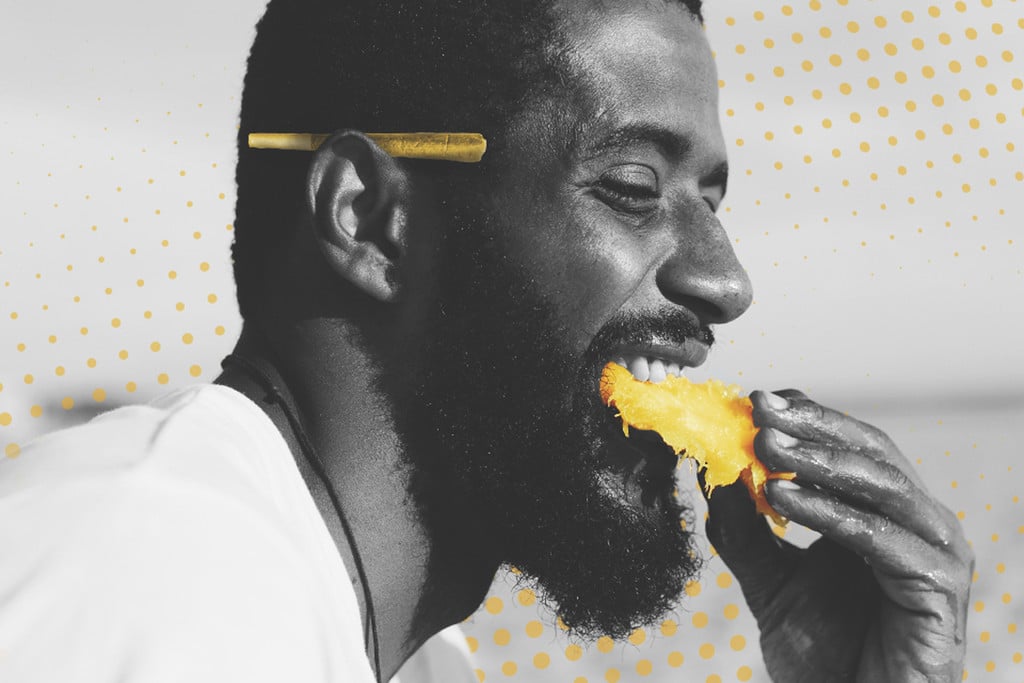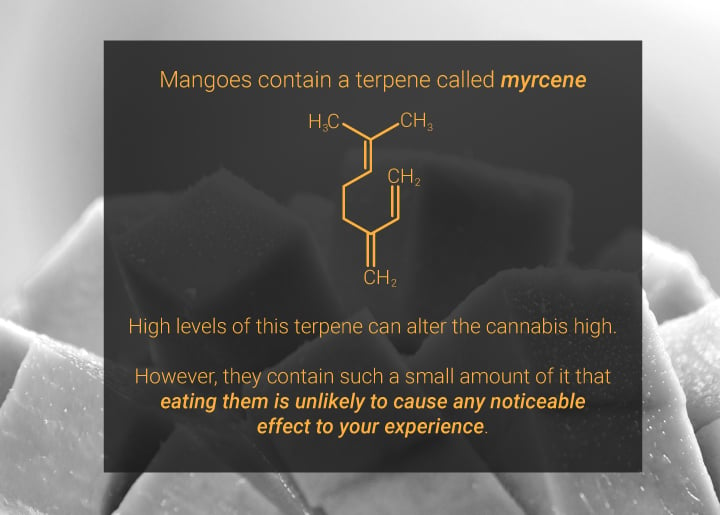.

Does Eating Mango Get You Higher?
Everybody loves a ripe mango. Nothing quite compares to the sweetness and hydration that every bite provides. While most people consume this fruit for the taste, others do so in hopes of boosting the effects of cannabis. Mangoes do contain key chemicals also found within weed, but does the tropical fruit really get you higher? Find out the truth.
Are mangoes and marijuana the perfect duo? This antioxidant-rich tropical fruit certainly helps to tackle the munchies and reduce cotton mouth, but some self-appointed weed gurus also claim that this juicy fruit holds the key to a more intense high.
The theory goes that mangoes possess special phytochemicals that allow more THC (the principal psychoactive component of cannabis) through the blood–brain barrier.
An increased quantity of THC in the brain results in greater receptor activation, which equates to a faster-acting and more powerful experience.
This all sounds great. But does one of the tastiest fruits found in nature really enhance the effects of the most popular recreational herb? Join us as we uncover the truth behind one of the most prolific cannabis rumours.
Contents:
Mango and the Myrcene Terpene
Like most people, you probably know mangoes as a delicious fruit found on supermarket shelves. But where do these ovals of goodness actually come from? Known by the Latin binomial Mangifera indica, this member of the cashew family derives from South and Southeast Asia, specifically around Myanmar, Bangladesh, and parts of India. Unlike cannabis, mangoes are monoecious, meaning each tree possesses both male and female reproductive organs.
Now that you’ve brushed up on your botany, let’s delve into phytochemistry. Advocates of mixing mango and weed state that terpenes present in the fruit underpin the purported high-enhancing effect. If you know anything about cannabis, you’ll have come across the term “terpene” at least once. These are the volatile aromatic molecules that give individual cannabis cultivars their unique flavour and aroma. It turns out that mangoes contain these pungent hydrocarbons too.
There are over 30,000 terpenes found in nature, and over 150[1] of them show up in cannabis. But which of these compounds form the phytochemical bridge between weed and mango? It all boils down to a fruity and earthy terpene known as myrcene.
Because the compound only contains 10 carbon atoms, myrcene autumns into a chemical class known as monoterpenes. It occurs as one of the most abundant terpenes in many cannabis cultivars, and likely influences the perceived effects of these varieties. Cannabis buds packed with myrcene tend to be particularly stoning and relaxing, and are associated with quintessential “indica” effects.

Does Mango Change the Way Weed Works in the Body?
Do mangoes actually make you higher? No studies have specifically observed the effects of combining cannabis and mango in human participants. However, we can draw links from research involving myrcene’s interaction with cannabinoids such as THC.
Myrcene alone produces some interesting effects. Researchers are currently assessing the molecule for sedating[2], anti-convulsant[3], and anti-anxiety[4] potential. In regard to anxiety, myrcene appears to influence GABA, the chief inhibitory neurotransmitter found in the central nervous system. By increasing the effect of GABA at the GABA-A receptor, myrcene could have an impact on anxiety.
Cannabinoids receive most of the credit for the effects of cannabis. However, researchers now posit that terpenes play a major role in the psychological effects of individual cultivars. While THC, CBD, and other cannabinoids form the core effects, terpenes steer the high in a particular direction. Cannabinoids and terpenes may even work together synergistically—a phenomenon known as the entourage effect. Ongoing studies[5] are looking to see if myrcene and CBD can work together to impact inflammation, and if THC can amplify the terpene’s sleep-promoting qualities.
The action of myrcene doesn’t end there. The chief claim among proponents of the weed–mango association is that the tropical fruit alters blood–brain barrier permeability. This might sound outlandish right out of the gate, but some evidence backs it up. A paper[6] published in Frontiers of Nutrition in 2021 suggests that myrcene may potentiate the effects of cannabinoids by lowering resistance across the blood–brain barrier, resulting in enhanced transportation of these compounds into the brain.
High levels of myrcene can alter the cannabis high, but keep in mind that both cannabis and mango possess fluctuating amounts of this phytochemical. Both genetic and environmental roles play a role in how much myrcene both of these plants contain. A study[7] published in the journal Phytochemistry assessed the constituents of 11 cannabis varieties, and found myrcene concentrations ranging from 0.04% all the way to 1.9%. Another study[8] looked at the volatile components of 20 mango cultivars and found levels of 0.09–1.29mg per kg.


So, does mango get you higher? Let’s break it down.
One cup of mango contains[9] 165g of sweet fruit, meaning one cup of even the most myrcene-rich variety serves up only 0.2mg of the terpene. The average joint contains roughly 0.3g[10]. Pack it with the most myrcene-rich cannabis you can find, and you’re looking at approximately 5.7mg of myrcene per joint.
Overall, one cup of a mango variety very low in myrcene will provide close to the same amount as a cannabis strain considerably low in the terpene. However, most modern strains are much higher in myrcene, meaning chowing down on a mango isn’t going to influence the phytochemical cocktail much at all.
Should You Consume Mango Before or After Smoking Weed?
Not only do mangoes contain less myrcene compared to cannabis, but it takes around 30 minutes[11] for the terpene to enter human plasma after consuming a dose. Therefore, if you want to tweak your high—incredibly subtly—then munch on a mango half an hour before you plan on smoking weed. Because mangos are unlikely to produce a significant physiological impact, you’re better off saving your ripe fruit for after to combat the munchies and dry mouth.
The Benefits of Eating Mango
Psychoactive interactions aside, mangoes pack a nutritional punch that makes them worth consuming whether you want to get higher or not. The tropical fruit contains a host of vitamins and minerals, including:
- Vitamin C
- Vitamin A
- Vitamin B6
- Magnesium
- Potassium
Alongside these crucial nutrients, mangoes also contain an array of phytochemicals that may benefit human health, such as:
- Carotenoids
- Flavonoids
- Terpenes
Do Other Foods Enhance the Effects of Cannabis?
A range of other common foodstuffs also interact with the endocannabinoid system. These ingredients are unlikely to get you higher, but you might find that they influence your high in a desirable way. Why not try making a dish featuring a few of these terpene/cannabinoid-containing ingredients? Some potential options include:
- Black pepper
- Cloves
- Truffles
- Carrots
- Brassicas
Mango and Weed: Don’t Get Your Hopes Too High
Does eating mango make you more high? At best, eating a boatload of the fruit could theoretically alter your high toward the stoning end of the spectrum. However, your bowels might not take too kindly to such a gluttonous endeavour.
Still, the mango and weed advocate got several things right. The fruit does contain myrcene, and early research suggests that the terpene influences blood–brain barrier permeability. However, even the most myrcene-rich mango varieties contain such low levels of the phytochemical that eating one before smoking cannabis will produce a negligible outcome. Yet, while it won’t transform your cannabis experience, mango still makes one of the best post-session snacks!
Ver esta publicación en Instagram
DisclaimerWhen consumed, THC metabolizes into 11-hydroxy-THC, which enters the body through the stomach and liver, resulting in a significantly stronger effect due to its increased affinity for CB1 receptors in the brain.
Ensure accurate portion control. Begin with small doses and gradually increase to develop tolerance.
Remember: Set and Setting will help you deal with various situations.
Stay Cultivated.
- https://www.sciencedirect.com/science/article/pii/S0168945219301190
- Central effects of citral, myrcene and limonene, constituents of essential oil chemotypes from Lippia alba (Mill.) n.e. Brown - PubMed https://pubmed.ncbi.nlm.nih.gov
- Anticonvulsant activity of essential oils and active principles from chemotypes of Lippia alba (Mill.) N.E. Brown - PubMed https://pubmed.ncbi.nlm.nih.gov
- The GABAergic system contributes to the anxiolytic-like effect of essential oil from Cymbopogon citratus (lemongrass) - PubMed https://pubmed.ncbi.nlm.nih.gov
- Taming THC: potential cannabis synergy and phytocannabinoid-terpenoid entourage effects - PMC https://www.ncbi.nlm.nih.gov
- Myrcene—What Are the Potential Health Benefits of This Flavouring and Aroma Agent? - PMC https://www.ncbi.nlm.nih.gov
- Metabolic fingerprinting of Cannabis sativa L., cannabinoids and terpenoids for chemotaxonomic and drug standardization purposes - PubMed https://pubmed.ncbi.nlm.nih.gov
- Volatile components from mango (Mangifera indica L.) cultivars - PubMed https://pubmed.ncbi.nlm.nih.gov
- Mango: Nutrition, Health Benefits, and How to Eat It https://www.healthline.com
- https://www.nytimes.com/2016/07/15/science/how-much-weed-is-in-a-joint-pot-experts-have-a-new-estimate.html
- Myrcene—What Are the Potential Health Benefits of This Flavouring and Aroma Agent? - PMC https://www.ncbi.nlm.nih.gov






































